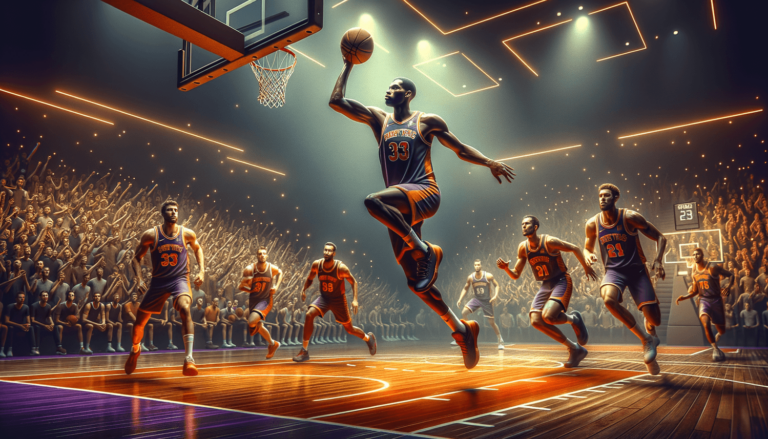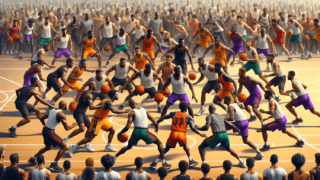
Welcome to the exciting world of basketball, where terms like “low post” can spark curiosity for hoops enthusiasts and newbies alike! In this fun yet professional guide, we’ll unravel the mysteries of the low post, a key component of strategy and gameplay. So, whether you’re a die-hard fan delving deeper into the sport or a curious newcomer eager to expand your basketball knowledge, let’s dive in as we unpack the fascinating world of the low post in basketball!
What’s a Low Post in Basketball?
A low post in basketball refers to the area near the block, close to the baseline and the two sides of the painted key. Offensively, it’s where big players, such as centers and power forwards, typically position themselves to create scoring opportunities through post-up moves or by exploiting mismatches. Defensively, the goal is to prevent opponents from capitalizing on low post plays while protecting the basket.
Understanding the Basketball Court: Setting the Stage for the Low Post
Before diving deep into the low post’s intricacies, it’s essential to know the layout of a standard basketball court. A basketball court consists of various lines and markings that define different areas, such as the three-point line, the key (or the paint), and the sidelines. These markings facilitate gameplay, positioning, and strategy, and the low post is directly related to these foundational elements.
Offense in the Low Post
Establishing Position
In basketball, occupying space effectively can provide significant advantages to a team’s offensive strategy. Establishing position near the low post, usually by a big player like a center or power forward, leads to high-percentage shots and creates an imposing presence in the paint. To make the most of this area, a player must position themselves on the strong side (the side with the ball) or the weak side (the side without the ball) and maintain the right balance between posting up and not clogging the paint for their teammates.
Post-Up Moves and Techniques
Utilizing the low post effectively requires a combination of skill, finesse, and power. Players in the low post often employ a series of post-up moves to create scoring opportunities. Here are several post-up moves that basketball players employ in the low post:
- Drop step: A quick pivot towards the baseline while using the inside foot, followed by a power move to the basket.
- Jump hook: A one-handed shot where a player jumps off both feet, hooking their shooting arm over the defender’s outstretched arm for a high-percentage shot.
- Up-and-under: A deceptive move where a player fakes a jump shot, dribbling under the defender’s outstretched arms, to complete a layup or a short jump shot.
- Turnaround jumper: A shot where a low post player rapidly pivots and takes a high-percentage jump shot while facing the basket.
- Face-up: Instead of having their back towards the basket, a player faces the defender and uses their size and footwork skills to initiate a one-on-one move to the basket.
Developing a versatile repertoire of these moves and techniques is crucial for success in the low post, as it keeps defenders guessing and enhances a team’s offensive options.
Exploiting Mismatches
One of the primary benefits of having a dominant offensive presence in the low post is the opportunity to exploit mismatches. Players with size or skill mismatches can cause havoc in the low post, drawing double-teams, opening up kick-out opportunities to the perimeter, or providing easy scoring chances. Recognizing and capitalizing on these mismatches is a cornerstone of a successful low post offense.
Defense in the Low Post
Individual Low Post Defense
Defending the low post requires determination, strength, and a solid understanding of defensive principles. Here are a few essential tips for shutting down low post scorers:
- Fronting: Denying the post player the ball by positioning oneself between them and the passer to limit their ability to catch and establish position in the low post.
- Three-Quarter Defense: Standing between the player with the ball and the offensive post player while maintaining a hand in the passing lane, making it difficult for the post player to receive a clean inbound pass.
- Bodying Up: Being physical with the offensive player without committing fouls, forcing them away from their preferred position on the low block.
- Shot Contesting: A defender’s ability to challenge every shot in the low post to make it as difficult as possible for the offensive player to score.
Team Help Defense
While individual defense is vital, the overall team defensive strategy significantly impacts how well the low post can be defended. Some key elements of team help defense in the low post are:
- Rim Protection: Ensuring a shot-blocking presence to challenge post scorers and deter potential drives.
- Weak Side Help: The weak side defender rotates to provide assistance when a teammate in the low post is beaten, while simultaneously being ready to recover to their original assignment if needed.
- Perimeter Rotation: The ability of perimeter players to timely rotate and help their teammates when necessary, creating a unified and cohesive defensive system.
Effective help defense can limit the options available to low post scorers, elevating the team’s overall defensive performance.
The Low Post in Modern Basketball
In the age of pace-and-space basketball, the role of the low post player and its relevance has evolved. As teams prioritize outside shooting, floor spacing, and fast-tempo play, the prototypical low post bruiser has become less prominent. However, several modern players excel in the low post or use their skill sets to create mismatches and versatile scoring options. Some of these exceptional players include Joel Embiid, Nikola Jokic, Anthony Davis, and Karl-Anthony Towns. The value of low post skills, both offensively and defensively, remains a critical component in a well-rounded and adaptable basketball game plan.
Developing Low Post Skills: Tips and Drills
The best way to become proficient in the low post is through consistent practice and targeted drills. Whether you’re an aspiring big man or a guard looking to diversify your skill set, mastering low post fundamentals can enhance your overall basketball game. Here are some useful drills to help you develop your low post skills:
Post Scoring Drills
- Mikan Drill: Named after Hall of Famer George Mikan, this drill involves shooting layups from the left and right side of the basket without dribbling, focusing on footwork, body control, and finishing with both hands.
- Chair Series: A set of drills that incorporate various post moves and finishes, such as the drop step or up-and-under, using a chair placed in the low post area to simulate a defender.
Defensive Post Drills
- Wall Sit: An effective exercise to build leg strength and stamina, essential for maintaining a proper defensive stance in the low post.
- Post Defense Slides: A drill that focuses on quick lateral movement and maintaining proper body balance while denying the offensive post player the ball.
Undertaking these and other targeted drills will help you become more comfortable and efficient in the low post, enhancing your game both on and off the court.
Strategic Significance of the Low Post
While the game of basketball continues to evolve, the low post remains an essential element of a winning team. The formidable offensive presence a skilled low post player brings combined with sound defensive work in the paint can dictate the course of matchups, cementing the low post’s significance in basketball strategy. Understanding the low post game, mastering its fundamentals, and recognizing in-game situations can give teams and players alike a significant edge on the court.
Increasing Versatility: Expanding Your Low Post Arsenal
A diverse skill set in the low post can become a formidable weapon for any basketball player. By complementing your existing low post abilities with related skills, you can elevate your offensive threat, making it increasingly challenging for opponents to guard you effectively. Here are some attributes and techniques to consider adding to your low post toolkit:
Passing Out of the Low Post
One underrated aspect of excellent low post play is passing. Skilled big men can transform from scorers to facilitators, finding open teammates for high-quality shots. The ability to pass from the low post can help you counter double teams, enhance ball movement and maintain offensive flow. Incorporate drills that focus on reading defenses, reacting to help from the weak side, and using bounce passes, skip passes, and over-the-top passes to distribute the ball effectively to your teammates.
Footwork and Agility
Great low post players understand the importance of adept footwork and agility for their effectiveness. Developing quick, precise footwork enhances your efficiency in the paint and facilitates seamless execution of different post moves. Consider agility-based drills like ladder workouts, stutter-steps, and quick reaction exercises to improve foot speed, control, and coordination. These skills will also significantly benefit your low post defense, as staying active and maintaining proper positioning are essential to limiting an opponent’s scoring chances.
Quicker Decision Making in the Post
Being able to make quick and accurate decisions in the low post is a valuable skill in today’s fast-paced basketball games. Recognize when to take your shot, pass to an open teammate or repost to improve your position for maximum advantage. Taking too much time in the low post can disrupt ball movement and hurt your team’s flow, which is why honing the ability to analyze situations and make high-percentage decisions rapidly is vital for any low post player.
History and the Notable Low Post Players
Over basketball’s rich history, many great players have excelled through their low post prowess, leaving indelible marks on the game. Examining these legends will give you a deeper understanding of the intricacies and evolution of low post play:
Shaquille O’Neal
Shaquille “Shaq” O’Neal, one of the most dominant low post presences in NBA history, combined extraordinary physicality with his unique combination of moves to overpower his opponents. With his unstoppable drop step, powerful finishes and solid footwork, Shaq proved why mastering the low post can make one nearly unguardable.
Hakeem Olajuwon
A two-time NBA champion, Hakeem “The Dream” Olajuwon epitomized finesse and footwork in the low post. Adept at multiple post moves, including his signature dream shake, Hakeem’s agility, and basketball IQ made him a nightmare for defenders. Studying his game provides valuable insights into becoming an agile and skillful low post player.
Tim Duncan
Nicknamed “The Big Fundamental,” Tim Duncan’s low post play was a cornerstone for the San Antonio Spurs’ consistent success during his tenure. Duncan’s superb footwork, balance, and ability to use both hands made his offensive game diverse and effective. His high-level defensive instincts and prowess underscored the importance of both offense and defense for low post success.
Kareem Abdul-Jabbar
As the NBA’s all-time leading scorer, Kareem Abdul-Jabbar dominated with his picturesque skyhook that he often initiated in the low post. Kareem demonstrated the power of mastering a unique skill to create a significant offensive advantage. His dominance in the low post serves as an inspiration and an aspiration for basketball players at all levels.
By reflecting on the methods and accomplishments of these low post legends, players can gain both motivation and valuable insights on the path to refining their low post abilities and creating pivotal contributions to their teams’ success.
Frequently Asked Questions: Low Post Basketball Insights
Seeking more insights about low post in basketball? Let’s explore some frequently asked questions (and their answers) that capture the essence of low post play, while providing practical tips and helpful context to help elevate your basketball knowledge and skills.
1. How do I become a dominant low post player?
To become a dominant low post player, focus on improving your footwork, strength, agility, and basketball IQ. Refine your post moves, work on establishing position and maintaining a strong base, sharpen your passing skills, and study your opponents. Consistent practice and implementation of targeted drills will help you become a more effective low post player.
2. Can guards benefit from learning low post skills?
Yes, guards can certainly benefit from learning low post skills. Developing an understanding of post moves and positioning enables guards to take advantage of mismatches and exploit smaller or less athletic defenders. Additionally, low post skills can help guards diversify their offensive repertoire and enhance their understanding of the game as a whole.
3. Are there different low post areas on the basketball court?
While the term ‘low post’ generally refers to the area near the block and close to the baseline and two sides of the painted key, there are two low post areas on the court: one on each side of the key. Players can operate from either the strong side (the side with the ball) or the weak side (the opposite side).
4. What is high post vs. low post in basketball?
The high post and low post represent distinct areas on the court, each offering strategic scoring opportunities. The high post refers to the area around the free-throw line extended and the elbows, while the low post designates the space close to the block, near the baseline, and along the key’s sides. Players usually adopt different moves and strategies depending on whether they’re operating in the high or low post.
5. Can small players excel in the low post?
Yes, smaller players can excel in the low post, provided they possess the appropriate skills, footwork, and basketball IQ. While smaller players may lack height, their speed, agility, and post techniques can grant them significant advantages. Examples of smaller players who have thrived in the low post include Charles Barkley and Kevin Love.
6. How can I improve my low post defense?
Improving low post defense requires a combination of physical strength, balance, quickness, and awareness. Incorporating drills targeting stance and positioning (e.g., fronting, three-quarter position), body control, lateral movement, and shot contesting will help enhance your low post defense. Studying your opponents and understanding their offensive tendencies can also contribute to your defensive success.
7. How has the low post’s importance changed in modern basketball?
In today’s game focused on pace, space, and perimeter shooting, the prototypical low post big man has become less prominent. However, the low post remains a crucial part of overall strategy, as dominant low post players can impose their presence, exploit mismatches, and generate various scoring opportunities. Additionally, versatility and passing ability have emerged as crucial traits that coincide with the evolving demands of modern basketball.
8. Which current NBA players excel in the low post?
Some current NBA players who excel in the low post include Joel Embiid, Nikola Jokic, Anthony Davis, and Karl-Anthony Towns. These players showcase the value of low post skills in versatility, creating mismatches, and producing effective scoring options in today’s fast-paced, space-driven game.
9. How can I practice low post moves on my own?
You can practice low post moves on your own by using items such as chairs, cones or marked locations to simulate defenders and simulate receiving dummy passes. Focus on footwork, positioning, and fluid execution of movements, and give equal attention to both sides of the court to develop ambidexterity.
10. Is the low post relevant for women’s basketball?
Yes, the low post is certainly relevant in women’s basketball, as it is for men’s basketball. Possessing a solid low post game is essential for teams in both the women’s and men’s games, as it helps maintain a balanced attack, exploit mismatches, and extend defense. Featuring well-rounded players skilled both inside and outside the painted area is a vital requirement for any competitive team, regardless of gender.
Featured Posts
- No pillar pages found.





